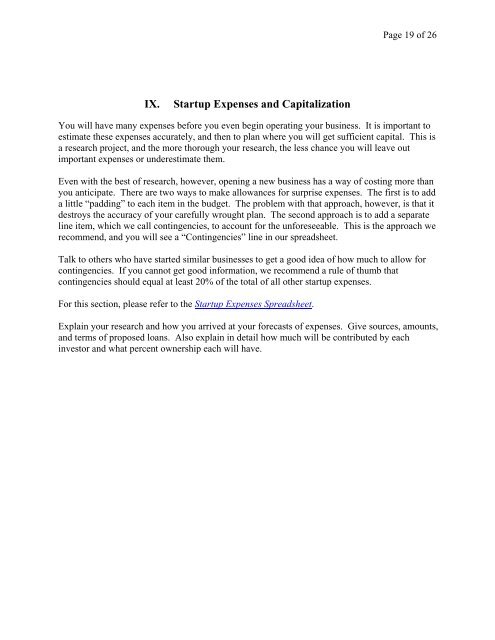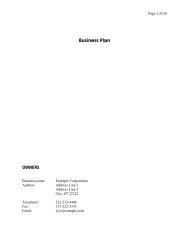BusinessPlanforStartupBusiness
Create successful ePaper yourself
Turn your PDF publications into a flip-book with our unique Google optimized e-Paper software.
Page 19 of 26<br />
IX.<br />
Startup Expenses and Capitalization<br />
You will have many expenses before you even begin operating your business. It is important to<br />
estimate these expenses accurately, and then to plan where you will get sufficient capital. This is<br />
a research project, and the more thorough your research, the less chance you will leave out<br />
important expenses or underestimate them.<br />
Even with the best of research, however, opening a new business has a way of costing more than<br />
you anticipate. There are two ways to make allowances for surprise expenses. The first is to add<br />
a little “padding” to each item in the budget. The problem with that approach, however, is that it<br />
destroys the accuracy of your carefully wrought plan. The second approach is to add a separate<br />
line item, which we call contingencies, to account for the unforeseeable. This is the approach we<br />
recommend, and you will see a “Contingencies” line in our spreadsheet.<br />
Talk to others who have started similar businesses to get a good idea of how much to allow for<br />
contingencies. If you cannot get good information, we recommend a rule of thumb that<br />
contingencies should equal at least 20% of the total of all other startup expenses.<br />
For this section, please refer to the Startup Expenses Spreadsheet.<br />
Explain your research and how you arrived at your forecasts of expenses. Give sources, amounts,<br />
and terms of proposed loans. Also explain in detail how much will be contributed by each<br />
investor and what percent ownership each will have.



